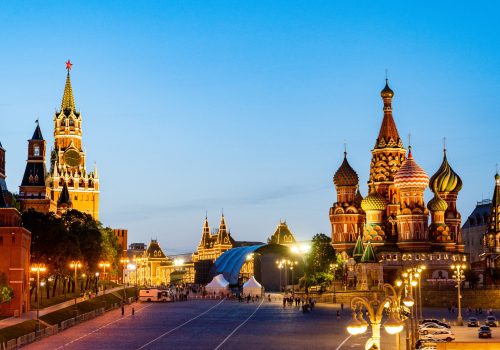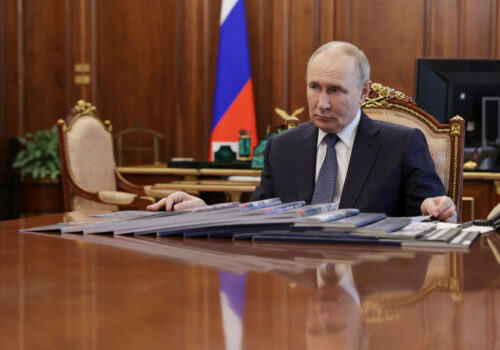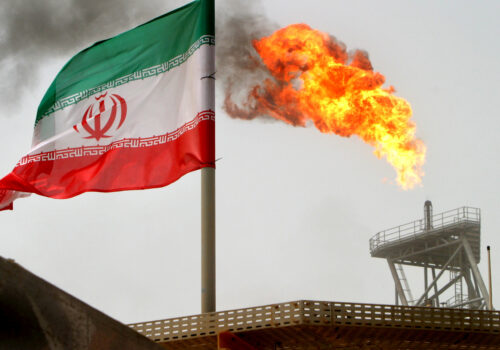To end Putin’s war on Ukraine, Trump should sanction Russian oil
Over the past two weeks, US President Donald Trump has shown the world that he can get Russian President Vladimir Putin to the table to discuss an end to the war in Ukraine, and he can coordinate and communicate with Western leaders. But the pageantry of these meetings does not hide the fact that the US president has not been able to successfully negotiate a peace deal. Nor does it hide Trump’s growing frustrations with Putin. To achieve such a deal, which would represent a signature strategic victory, Trump will need more leverage over Putin. He can create this leverage by imposing secondary sanctions on Russia’s oil.
Russia’s economy is struggling. Nearly four years of war expenses combined with Western sanctions have put Moscow’s economy on a wartime footing. Inflation and interest rates remain high at 8.8 percent and 18 percent, respectively. The Russian government continues to draw down its National Welfare Fund to cover its fiscal deficit. Energy exports, especially oil, remain a lifeline for Russia even though they are declining. Putin, quite literally, cannot afford to lose his remaining oil revenue.
Russia’s National Welfare Fund
Russia continues to drain its financial safety net to cover the costs of war and fund its economy. Russian economists recently assessed that the country is in jeopardy of depleting its National Welfare Fund by 2026, warning that as of June the fund only maintained $36 billion in liquid assets. This is the lowest it has been in more than five years.
Gold makes up about 40 percent of assets held in the National Welfare Fund. Market uncertainty and increased volatility in response to evolving US tariffs and bilateral trade deals, as well as other monetary policy risks, are driving investors toward gold as a safe-haven asset instead of the US dollar. As a result, gold prices surged to record highs in the spring and have been holding steady at over $3,300 per ounce, which benefits Russian coffers. High gold prices, coupled with lax sanctions enforcement, have helped Russia recover value in the National Welfare Fund, which can prolong the Kremlin’s ability to fund its war. However, Russia’s gold is finite and, according to press reporting, the government only has 139.5 metric tons of gold left—a significant decline from the more than 400 metric tons it held before its full-scale invasion of Ukraine in February 2022. If Moscow cannot generate revenue from energy sales, then it will need to tap into its remaining gold reserves to cover its spending, which will push Russia into further fiscal and economic decline.
This predicament creates the perfect target for sanctions—Russian oil.
Russia’s oil exports
The Group of Seven (G7) sixty-dollar-a-barrel price cap on Russian oil, coupled with sanctions on financial institutions such as Gazprombank, have restricted Moscow’s energy revenues. Despite these restrictions, Russia continues to generate income from the sale of its oil. In July, for example, it brought in $9.8 billion from oil and gas exports. Notably, this is a 27 percent decrease from a year earlier, further restricting Russia’s budget.
Russia continues to export most of its oil to China and India. Some of these transactions are compliant with the G7 price cap, while other transactions are the result of sanctions-evasion techniques, such as the shadow fleet and what Russia’s deputy trade commissioner has called a “very, very special mechanism” with Indian buyers.
Earlier this month, the Trump administration announced 25 percent tariffs on Indian goods as a punishment for India buying Russian oil. The tariff rate is scheduled to go up to 50 percent on August 27 if India continues to buy Russian crude. However, the tariffs have not deterred Russia from supplying oil to India or deterred India and China from buying it. In fact, China appears to be increasing its purchases of Russian oil, despite Trump’s warning that he may consider retaliatory tariffs on Beijing in the coming weeks. Secondary tariffs are bringing Russia, China, and India closer together and strengthening their economic ties. This runs the risk of weakening US and European economic leverage in peace negotiations between Russia and Ukraine.
The United States needs to strengthen the West’s negotiating position and create more leverage to end Russia’s war on Ukraine. Sanctioning Russia’s oil, similar to the approach the United States took against Iran, will immediately disrupt Moscow’s oil revenue. With the safety net of the National Welfare Fund dwindling, Putin would have no choice but to negotiate with Western leaders to end Russia’s war.
In addition, imposing secondary sanctions on Russian oil will force India, China, and other buyers to comply with US sanctions or risk losing access to the US-led global financial system. Licenses and exemptions can be used to mitigate unintended consequences, while increased production by the group of oil-producing countries known as OPEC+ can help offset the loss of Russian oil on the market. In exchange for a peace deal and security guarantees for Ukraine, the United States and Western partners can offer to lift sanctions and other restrictive measures that would allow the return of Russian oil to the market and save Russia’s economy from ruin. Such a peace deal should include, but not be limited to, Russia dropping its claims on Ukrainian territory, returning all Ukrainian children and prisoners of war, dropping court cases against Western companies complying with sanctions, making financial commitments for Ukraine’s reconstruction, agreeing to the deployment of a European-led deterrent force in Ukraine.
To start increasing financial pressure on the Kremlin, the US Treasury can close gaps between US and European Union (EU) sanctions on the shadow fleet by targeting the additional 105 vessels and companies involved in the shadow-fleet value chain that the EU targeted in July. Further, the US Treasury can target Russian oil companies including Gazprom, Lukoil, and Rosneft, which are currently subject to restrictions, but not subject to primary sanctions by the United States. The US Treasury can target Russian vessels operating outside of the shadow fleet, ports, and port operators, as well as service providers for seaborne and pipeline oil flows. The US Treasury can enforce existing sanctions on oil companies and producers, such as Gazprom subsidiary Gazprom Neft and Surgutneftegas. Enforcement includes following through on threats of secondary sanctions targeting the foreign financial institutions involved in transactions for Russian oil and oil-derived products. Existing executive orders provide the authority to target this activity, and new executive orders and legislation are not required. As the very least, simply enforcing the actions that have already been taken will have a significant impact on Russian oil revenues.
“Leverage: don’t make deals without it”
To Trump’s credit, his personal relationship with Putin creates the opportunity for dialogue and opens lines of communication that were previously closed. The US president is well positioned to bring about peace and achieve security guarantees for Ukraine, but his administration needs to arm him with the best tools and options to do so.
In Trump: The Art of the Deal, Trump wrote, “Leverage: don’t make deals without it.” Sanctioning Russia’s oil and cutting off their revenue is the leverage Trump needs to negotiate an end to this bloody war and a lasting peace deal for Ukraine.
Kimberly Donovan is the director of the Economic Statecraft Initiative within the Atlantic Council’s GeoEconomics Center. She is a former senior Treasury official and National Security Council director.
Further reading
Tue, Jul 29, 2025
The Russia pressure menu: Options to convince Putin to negotiate on Ukraine
New Atlanticist By John E. Herbst
As the US president cuts his deadline for Russia to ten days, there are several options for him to increase pressure on Moscow to pursue peace.
Tue, Jul 1, 2025
The US must enforce sanctions to prevent Iran from rebuilding its nuclear program
New Atlanticist By Kimberly Donovan
To ensure that Tehran cannot get its hands on the financial resources it would need to rebuild its nuclear program, Iran sanctions enforcement should start with China.
Thu, May 22, 2025
Gold’s geopolitical comeback: How physical and digital gold can be used to evade US sanctions
New Atlanticist By Kimberly Donovan, Maia Nikoladze
The rise of gold-backed currencies that circumvent the US banking system could create a massive blind spot for US sanctions enforcement efforts.
Image: An employee works at Gazprom Neft's Omsk Lubricant Plant (OZSM) in Omsk, Russia November 18, 2022. REUTERS/Olesya Astakhova




